#king kashyapa
Photo

Sigiriya Fortress
Sigiriya, aka Sinhagiri, is an ancient rock fortress in Sri Lanka. According to the ancient chronicles, this area was a large forest; however, it became a hill after the storms and landslides. Then, the hill became the new capital of Sri Lanka in the 5th century AD. King Kashyapa (477- 495) built a palace decorated with frescoes on top of it. He also built a gateway in the shape of an enormous lion on a plato leading to the palace. This gateway also gave the fortress its name, “Sinhagiri,” meaning the lion rock.
Photo: jordhammond
#sigiriya fortress#fortress#sinhagiri#rock fortress#sri lanka#history#king kashyapa#palace#frescoes#lion rock#jordhammond
4 notes
·
View notes
Text
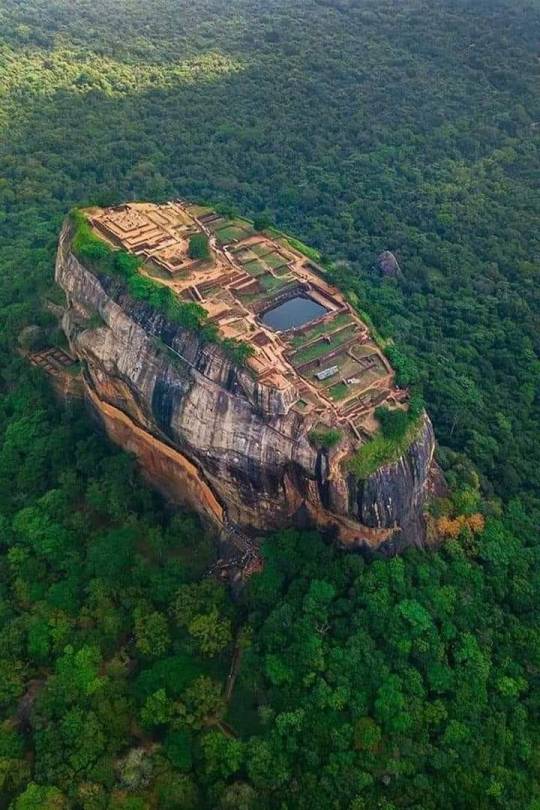
Sigiriya is an archaeological site in central Sri Lanka. It consists of the ruins of an ancient palace, built during the reign of King Kashyapa (477-495 AD). It is one of the eight World Heritage Sites of Sri Lanka and a favorite attraction for foreign tourists. Protected by UNESCO
Read more: https://news156media.com/the-lion-fortress-of-sri-lanka-was-swallowed-by-the-jungle/
306 notes
·
View notes
Text

Sigiriya Rock - sigiriya, SriLanka
Sigiriya rock is about 200 meters in height and is a UNESCO listed World Heritage Site. The rock has great historical and archaeological significance and is widely known as the eighth wonder of the world. Sigiriya Rock was used by the ancient King Kashyapa as his Royal Palace. The king used it as a hideout and a way of protecting himself and his kingdom from enemies. Sigiriya Rock is one of the best preserved examples of ancient urban planning. Photo credit @chocodolly_walker
#travel#tourism#srilanka#attractionsinsrilanka#travel photography#beautifuldestinations#sigiriya#history#travel ideas#travel destinations#best travel blogs
2 notes
·
View notes
Text
Unknown Facts about Apsaras
Apsaras are celestial nymphs, who are extremely gorgeous and wonderful dancers. They entertain devas in Indraloka with their dance. They are said to be the partners of Gandharvas who are celestial singers in the court of Indra. Apsaras are fascinating beings with several lesser-known facts and intriguing aspects:
1. Origins and Birth: Apsaras are believed to have emerged during the churning of the cosmic ocean (Samudra Manthan) by gods and demons to obtain the nectar of immortality (amrita). They are considered the daughters of the sage Kashyapa and his wife Muni, making them siblings of the Devas, Gandharvas, and Nagas. They came from meruka parvat during the Samudra manthanam
2. Characteristics and Abilities: Apsaras are renowned for their exceptional beauty, grace, and talent in dance and music. They are said to possess the ability to change their forms at will, enchanting both gods and humans with their charm and allure.
3. Associations and Roles: While apsaras are often associated with Indra, the king of the gods, and are depicted as companions and entertainers in his court, they are not limited to this role. They are also seen serving other deities, including Kubera, the god of wealth, and Varuna, the god of water.Varieties: In some texts, apsaras are classified into different categories based on their abilities and attributes. For example, there are apsaras known for their beauty (Sundaris), those skilled in dance (Nritya Siddhi), and those associated with specific elements like water (Varunapriya).
#collaboration#dealinbarters#sell#collab#trade#b2b#exchange#partnership#collaborate#cashless#barter#b2bsales#collaborationindia#bartersis#openbarter#bartering#barterbooks#bartercollaboration#barter6#bartersystem#marketing#advertisingandmarketing#strategy#sales#branding#business#fashion#networking#India#management
0 notes
Text
Unveiling the Mysteries of Sigiriya Rock: Exploring the Ancient Citadel
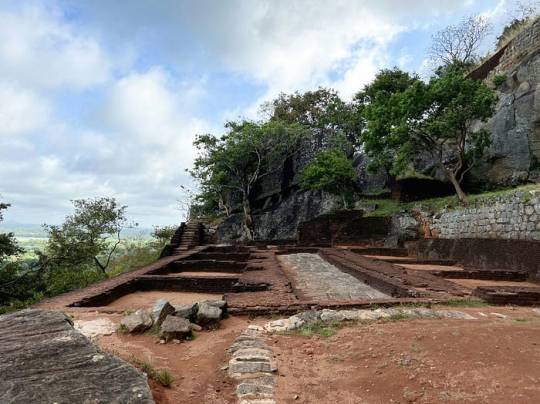
Sigiriya Rock stands as a testament to Sri Lanka’s rich history, captivating visitors with its awe-inspiring presence and enigmatic allure. Perched majestically amidst the lush greenery of the island, this ancient citadel holds within its walls secrets that have intrigued historians, archaeologists, and travelers alike for centuries. Let’s embark on a journey to uncover the hidden treasures and unravel the mysteries of Sigiriya Rock.
The Historical Marvel of Sigiriya
Dating back to the 5th century AD, Sigiriya served as the royal residence and fortress of King Kashyapa I, a visionary monarch of ancient Sri Lanka. Its strategic location atop a towering rock formation provided unparalleled defense against invaders, while its intricate architectural design showcased the ingenuity and sophistication of ancient engineering.
Archaeological wonders await those who ascend Sigiriya’s summit. The famed “Mirror Wall,” adorned with ancient graffiti and frescoes depicting celestial maidens, offers a glimpse into the vibrant culture and artistic prowess of the Sigiriya inhabitants. Each step taken on the winding staircases of Sigiriya echoes with whispers of the past, inviting visitors to delve deeper into its history.
Unraveling the Enigmatic Secrets
Beyond its surface grandeur, Sigiriya Rock conceals a plethora of mysteries waiting to be unveiled. From the purpose of its mesmerizing frescoes to the significance of its elaborate water gardens, every facet of Sigiriya holds a story begging to be told.
One of the most enduring enigmas surrounding Sigiriya is the purpose of its construction and the eventual fate of King Kashyapa. Some speculate that Sigiriya served as a symbol of the king’s power and ambition, while others suggest it was a sanctuary shrouded in secrecy. The tragic demise of King Kashyapa adds another layer of intrigue to Sigiriya’s narrative, leaving historians to ponder over the true motives behind its creation.
Exploring Sigiriya Today
Despite the passage of time, Sigiriya continues to captivate the imagination of visitors from around the globe. Its designation as a UNESCO World Heritage Site ensures its preservation for future generations to experience and appreciate.
Today, travelers can embark on guided tours of Sigiriya, led by knowledgeable experts who shed light on its historical significance and architectural marvels. The breathtaking views from the summit offer a glimpse into Sri Lanka’s natural beauty, providing a serene backdrop for reflection and contemplation.
Conclusion
Sigiriya Rock stands as a testament to the ingenuity, creativity, and resilience of ancient civilizations. Its towering presence and enigmatic allure continue to fascinate and inspire, inviting travelers to embark on a journey through time and uncover the secrets of an ancient citadel. As we explore Sigiriya’s historical marvels and unravel its mysteries, we gain a deeper appreciation for the rich tapestry of human history woven into its very foundations.
0 notes
Text



Source: tenor.com (addition via xlntwtch2.tumblr)
from wiki:
"The name of this place is derived from this structure; Siṃhagiri, the Lion Rock. The capital and the royal palace were abandoned after the king's death. It was used as a Buddhist monastery until the 14th century. Sigiriya today is a UNESCO listed World Heritage Site. It is one of the best preserved examples of ancient urban planning...."
...about 590 ft tall...
According to the ancient Sri Lankan chronicle the Cūḷavaṃsa, this area was a large forest, then after storms and landslides it became a hill and was selected by King Kashyapa (AD 477–495) for his new capital. He built his palace on top of this rock and decorated its sides with colourful frescoes. On a small plateau about halfway up the side of this rock he built a gateway in the form of an enormous lion. The name of this place is derived from this structure; Siṃhagiri, the Lion Rock...."
1 note
·
View note
Text
Sri Lanka - Part Two
Allen Continues his Exploration of this beautiful land
231125 A challenging day (writes Allen). We are going to climb the next UNESCO site, the Lion Rock. 5000 years ago. King Kashyapa (AD 477–495) built this palace/fortress on top of this rock and decorated its sides with colourful frescoes.
Sīnhāgiri, the Lion Rock
It is accessible only through the mouth of an enormous carved lion. Hence the…

View On WordPress
0 notes
Text
Tourism in Sigiriya
Sigiriya is a UNESCO World Heritage Site located in the Matale District of Sri Lanka. It is famous for its ancient rock fortress, which was built by King Kashyapa in the 5th century AD. The fortress is located on a massive rock that rises 200 meters (656 ft) above the surrounding plain. It is surrounded by gardens, ponds, and caves.
Sigiriya is a popular tourist destination, and there are many things to see and do in the area. In addition to the rock fortress, there are also several other historical sites, such as the Pidurangala Rock, the Royal Pleasure Gardens, and the Mirror Wall. There are also many opportunities for hiking, camping, and bird watching in the surrounding area.
The best time to visit Sigiriya is during the dry season, which is from November to April. However, the area can be visited year-round.
Here are some of the things you can do in Sigiriya:
Visit the Sigiriya Rock Fortress: This is the main attraction in Sigiriya and is a UNESCO World Heritage Site. The fortress is located on a massive rock that rises 200 meters (656 ft) above the surrounding plain. It is surrounded by gardens, ponds, and caves.

Sigiriya Rock Fortress in Sri Lanka
Hike to the Pidurangala Rock: This is a smaller rock that is located near Sigiriya Rock Fortress. The hike to the top of the rock offers stunning views of Sigiriya and the surrounding area.
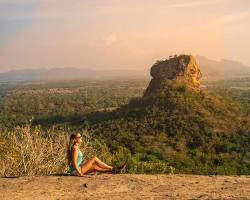
Pidurangala Rock in Sri Lanka
Visit the Royal Pleasure Gardens: These gardens were built by King Kashyapa and are located at the base of Sigiriya Rock Fortress. The gardens are home to a variety of plants and flowers, as well as a number of water features.
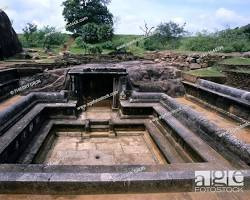
Royal Pleasure Gardens in Sri Lanka
See the Mirror Wall: This is a polished granite wall that is located at the base of Sigiriya Rock Fortress. The wall is covered in graffiti, which is believed to have been written by visitors to the fortress centuries ago.

Mirror Wall in Sri Lanka
Go bird watching: The area around Sigiriya is home to a variety of birds, including peacocks, eagles, and owls. There are a number of bird watching trails in the area.
If you are planning a trip to Sri Lanka, be sure to add Sigiriya to your itinerary. It is a truly magical place that is sure to leave you in awe.
#Sigiriya#SigiriyaRockFortress#UNESCOWorldHeritageSite#SriLanka#SriLankanTourism#SigiriyaTourism#SigiriyaHiking#PidurangalaRock#RoyalPleasureGardens#MirrorWall#BirdWatching#TravelSriLanka#VisitSriLanka
0 notes
Text
Mythological Girls: Nagini/Manasā
Apr 6, 2018
Naga and Nagini. Temple of Chennakeshava at Belur, India. Photo by Jean-Pierre Dalbéra.
Nagini is the Sanskrit word for a female deity who takes the form of a large snake, usually a king cobra but occasionally any others in the ‘naja’ genus. Her type appears in the Indian forms of Hinduism, Buddhism, and Jainism, where she is occasionally a counterpart to a male ‘naga’.
The most prominent nagini in Hinduism is Manasā, the goddess of snakes. She is specifically invoked as a prevention and cure for snakebites, which are common in the region. However, she is also known to be worshipped for fertility and prosperity elements as well. Manasā is predominantly based in Bengal, but can also be found in surrounding areas of north, northeastern, and southern India. She is depicted as a woman who is either covered with snakes while sitting on a lotus, or standing on the back of a snake. While seated, she is almost always sheltered by the hoods of seven cobras who line behind her. Occasionally while being invoked for fertility, she is depicted with a child on her lap as well.
Originially, Manasā was exclusively worshipped in local tribes. However, her popularity led to these followers adopting her into their Hindu practices and rituals. After a period of this, the higher classes of India fully absorbed her into the Hindu Pantheon. As a result, she is now regarded as a Hindu deity. Despite this formal connection to Hinduism, she largely remains a village deity. These villagers will worship her throughout the year, and will often perform a variety of songs and dances in her honour. Some villages refer to her as ‘Vishahara’, a deity who is known for curing a variety of poisons.
Her adoption as a Hindu deity led to a formal acknowledgement that her parents were Kashyapa and Kadru, the latter being a deity. This inclusion also led to their being considered as the parents to a further thousand nagas. She is occasionally considered as the daughter of Shiva, while being considered for her fertility aspects. This connection is furthered by several myths stating that she saved Shiva after he accidentally drank poison, as the ‘remover of poison’.
Most myths relating to Manasā portray her as being foul-tempered and unhappy. This appears to be because of her rejection from Shiva as a formal deity, as she is part mortal. Her aim in most of these stories appears to be to fully establish herself as a goddess in her own right, and accumulate her own devout following. She is told as being kind to those who do already worship her, and harsh on all those who do not.

0 notes
Text





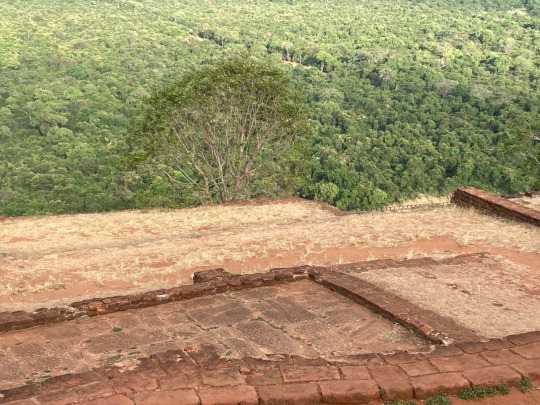




This afternoon I climbed Lion Rock/Sigiriya Rock. It is an ancient rock fortress selected by King Kashyapa (AD 477–495) for the new capital. The rock is 590ft high, there are lots of steps - I am not a proper climber!
It was refound in 1831, but archeological exploration didn’t start until the 1890s. There is the remains of a palace up top, but it is the views for climb the rock for.
1 note
·
View note
Text
On Lord Varaha, "The Bridegroom of Laughter."
The Boar god, Varaha originates from an ancient Hindu legend about a greedy king the gods eventually had to deal with.
The discussion about boar shaped gods and their origins in the quality of Vishnu, "Pervasive Grace" and the fight between grace and greed is germane to persons of all ages and eras.
The same is true of the subsequent stage of Vishnu, "Narasinha" the man-lion who fights a devil who lusts after an infinite amount of license.
It is not idolatry to allow the mind rest and then focus upon the meaning of these struggles and why the animal-god nature must always triumph over the infernal nature of man.
Now read on...
In ancient times there were two brothers named Hiranyakashipu and Hiranyaksha. They were demons born to sage Kashyapa Muni. They flaunted uncommon bodily features and had steel-like frames which grew just like mountains. Their bodies became so tall they seemed to kiss the sky with the crests of their golden crowns. They blocked the view in all directions, and while walking shook the earth with their every step.
The younger demon, Hiranyaksha, was a greedy exploiter of gold. He exploited enough gold from the earth so as to cause it to spin out of orbit. It then fell into the ocean.
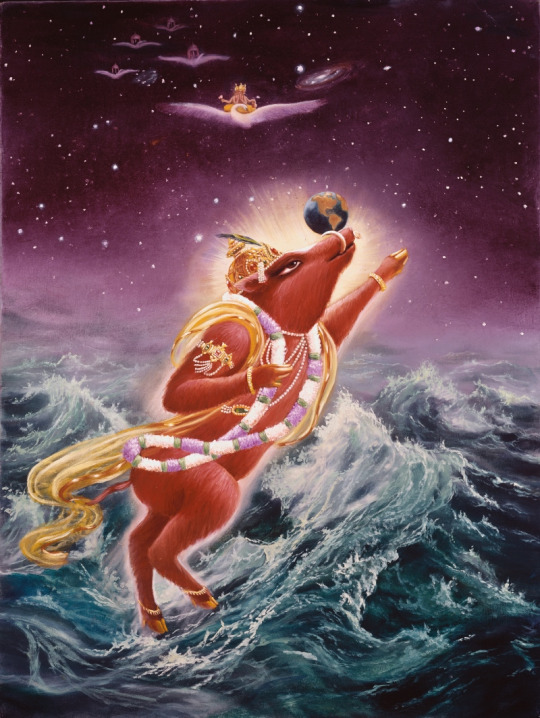
Lord Brahma who was the creator of the Universe was thinking of how to lift the earth which was submerged in water. At this time, the small form of a boar came out of his nostril. The measurement of the creature was not more than the upper portion of a thumb. While Brahma was looking at it, that boar became situated in the sky like a gigantic elephant. Then the boar roared like a rolling mountain. Brahma and the other demigods who saw this came to know that he was an incarnation of Lord Krishna and offered their prayers.
Lord Varahadeva Saving Earth
Playing like an elephant, Lord Varaha (the boar) flew in the sky, slashing his tail, his hard hairs quivering. He scattered the clouds in the sky with his hooves and glittering white tusks. As Lord Krishna had assumed the form of a boar He searched for the earth by smell. Diving into the water like a giant mountain, He split the ocean into two huge waves. Lord Varaha penetrated the water with His hooves, sharp like arrows. There he saw the earth, the resting place for all living beings, lying as it was in the beginning of creation. Then He easily took the earth on His tusks and lifted it out of the water. With His anger glowing like molten coals, Lord Varaha then accosted the demon Hiranyaksha.

Thereupon Lord Varaha killed the demon within the water, just as a lion kills an elephant. The cheeks and tongue of the Lord became smeared with the blood of the demon, just as an elephant becomes reddish from digging in the purple earth.
In this manner the Personality of Godhead, Lord Krishna the maintainer of all living entities, raised the earth from within the water, and having placed it afloat on the water, He returned to His own abode.
->Water in all religions is the reflective and contemplative surface in which we are born and also reborn as we struggle to grow up, find our humanity, then our divinity, then the Self.
The struggle between the miser, the less violent and greedy of the twin demons mentioned above, and the Boar god indicate the lust for gold must be an early desire we conquer. Boars are fairly unsophisticated aspects of human nature compared to the upper stages that follow.
Narasinha, a violent but fully balanced approach to the lust for power exceeds the boar, and finally a little man, called Vamana "a temporary little man" also a "painted man" is next.
All of these are painted men, temporary phases of a growing person who is trying to find and sustain the experience of the Grace of God called "Vishnu" without satisfying excessive desires, resorting to tantrums or tyranny when he becomes exhausted.
1 note
·
View note
Text
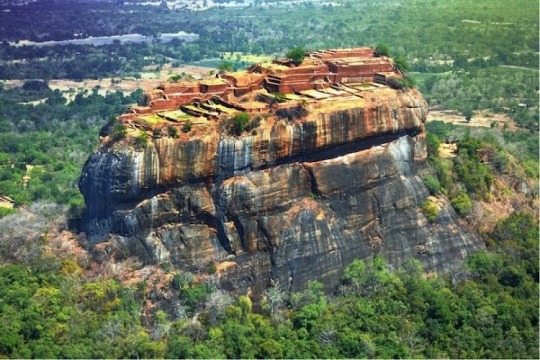





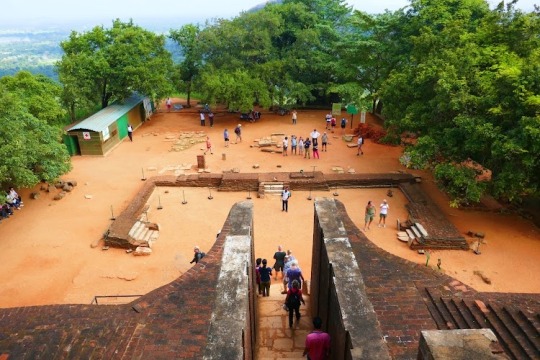
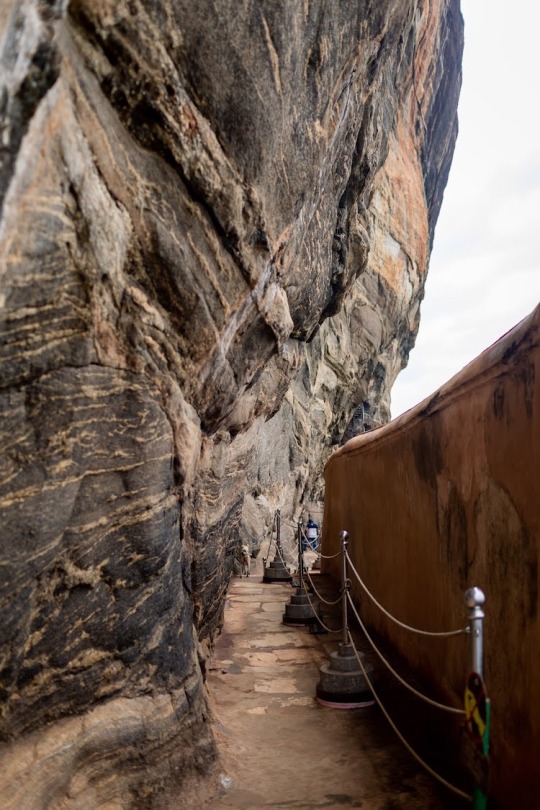


Sigiriya
Sigiriya or Sinhagiri (Lion Rock Sinhala: සීගිරිය, Tamil: சிகிரியா/சிங்ககிரி, pronounced see-gi-ri-yə) is an ancient rock fortress located in the northern Matale District near the town of Dambulla in the Central Province, Sri Lanka. It is a site of historical and archaeological significance that is dominated by a massive column of rock approximately 180 m (590 ft) high.[2]
Sigiriya
Aerial view of Sigiriya Rock
Location
Central Province, Sri Lanka
Coordinates
07°57′25″N 80°45′35″E
Elevation
349 m (1,145 ft)[1]
Built for
King Kashyapa of Sri Lanka
Visitors
1 million
Governing body
Government of Sri Lanka
Website
www.sigiriyafortress.com
UNESCO World Heritage Site
Official name
Ancient City of Sigiriya
Type
Cultural
Criteria
ii, iii, iv
Designated
1982 (6th session)
Reference no.
202
UNESCO Region
Asia-Pacific
Location of Sigiriya in Sri Lanka
According to the ancient Sri Lankan chronicle the Cūḷavaṃsa, this area was a large forest, then after storms and landslides it became a hill and was selected by King Kashyapa (AD 477–495) for his new capital. He built his palace on top of this rock and decorated its sides with colourful frescoes. On a small plateau about halfway up the side of this rock he built a gateway in the form of an enormous lion. The name of this place is derived from this structure; Sīnhāgiri, the Lion Rock (an etymology similar to Sinhapura, the Sanskrit name of Singapore, the Lion City).
The capital and the royal palace were abandoned after the king's death. It was used as a Buddhist monastery until the 14th century.[3] Sigiriya today is a UNESCO listed World Heritage Site. It is one of the best preserved examples of ancient urban planning.[4]
History
Historical past
It is likely that the area around Sigiriya may have been inhabited since prehistoric times. There is clear evidence that the many rock shelters and caves in the vicinity were occupied by Buddhist monks and ascetics from as early as the 3rd century BC. The earliest evidence of human habitation at Sigiriya is the Aligala rock shelter to the east of Sigiriya rock, indicating that the area was occupied nearly five thousand years ago during the Mesolithic Period.
Buddhist monastic settlements were established during the 3rd century BC in the western and northern slopes of the boulder-strewn hills surrounding the Sigiriya rock. Several rock shelters or caves were created during this period. These shelters were made under large boulders, with carved drip ledges around the cave mouths. Rock inscriptions are carved near the drip ledges on many of the shelters, recording the donation of the shelters to the Buddhist monastic order as residences. These were made in the period between the 3rd century BCE and the 1st century AD.
In 477 AD, Kashyapa I, the king’s son by a non-royal consort, seized the throne from King Dhatusena, following a coup assisted by Migara, the King’s nephew and army commander. The rightful heir, Moggallana, fearing for his life, fled to South India. Afraid of an attack by Moggallana, Kashyapa moved the capital and his residence from the traditional capital of Anuradhapura to the more secure Sigiriya. During King Kashyapa’s reign (477 to 495 AD), Sigiriya was developed into a complex city and fortress.[3][4] Most of the elaborate constructions on the rock summit and around it, including defensive structures, palaces, and gardens, date from this period.
The Cūḷavaṃsa describes King Kashyapa as the son of King Dhatusena. Kashyapa murdered his father by walling him up alive and then usurping the throne which rightfully belonged to his half-brother Moggallana, Dhatusena's son by the true queen. Moggallana fled to India to escape being assassinated by Kashyapa, but vowed revenge. In India he raised an army with the intention of returning and retaking the throne of Sri Lanka, which he considered to be rightfully his. Expecting the inevitable return of Moggallana, Kashyapa is said to have built his palace on the summit of Sigiriya as a fortress as well as a pleasure palace. Moggallana finally arrived, declared war, and defeated Kashyapa in 495 CE. During the battle Kashyapa's armies abandoned him and he committed suicide by falling on his sword.
The Cūḷavaṃsa and folklore inform us that the battle-elephant on which Kashyapa was mounted changed course to take a strategic advantage, but the army misinterpreted the movement as the king's having opted to retreat, prompting the army to abandon him altogether. It is said that being too proud to surrender he took his dagger from his waistband, cut his throat, raised the dagger proudly, sheathed it, and fell dead. Moggallana returned the capital to Anuradhapura, converting Sigiriya into a Buddhist monastery complex,[5] which survived until the 13th or 14th century. After this period, no records are found on Sigiriya until the 16th and 17th centuries, when it was used briefly as an outpost of the Kingdom of Kandy.
<img src="//upload.wikimedia.org/wikipedia/commons/thumb/1/1f/Sigiriya_Luftbild_%2829781064900%29.jpg/450px-Sigiriya_Luftbild_%2829781064900%29.jpg" decoding="async" width="450" height="253" class="thumbimage" data-file-width="3241" data-file-height="1820">
Sigiriya Rock from above
Alternative stories have the primary builder of Sigiriya as King Dhatusena, with Kashyapa finishing the work in honour of his father. Still other stories describe Kashyapa as a playboy king, with Sigiriya his pleasure palace. Even Kashyapa's eventual fate is uncertain. In some versions he is assassinated by poison administered by a concubine; in others he cuts his own throat when deserted in his final battle.[6] Still further interpretations regard the site as the work of a Buddhist community, without a military function. This site may have been important in the competition between the Mahayana and Theravada Buddhist traditions in ancient Sri Lanka.
In Professor Senarath Paranavithana's book The Story of Sigiriya, King Dathusena is said to have taken the advice of the Persian Nestorian Priest Maga Brahmana on building his palace on Sigirya. According to Paranavithana, during this period over seventy-five ships carrying Murundi soldiers from Mangalore arrived in Sri Lanka and landed in Chilaw to protect King Dathusena, most of them Christians. King Dathusena's daughter was married to Migara, a Christian and the commander of the Singhalese army
0 notes
Text

Sigiriya Rock - sigiriya, SriLanka
Sigiriya Rock was used by the ancient King Kashyapa as his Royal Palace. It is about 200 meters in height and is a UNESCO listed World Heritage Site. The rock has great historical and archaeological significance and is widely known as the eighth wonder of the world.
Photo credit @mattwoodvisuals
2 notes
·
View notes
Text
Religious Tourism In Nellore
TEMPLES IN NELLORE
Nellore city

Ranganatha Swamy Temple
Sri Talapagiri Ranaganatha swamy Temple is located in Nellore city and is about 5kms away from Nellore Bus stand. RanganadaSwamy Temple in Nellore is more than 600years old. This temple is situated on the banks of the river Pennar and is marked by a huge 29 Mts tall Galigopuram with seven gold kalasams and its architectural splendour. The annual Rath Yathra of the God is a much awaited ritual in Nellore. There are seven kalisams, which brings beauty to the temple. Every year during the month of March-April (varies according to Hindu calendar) grand festival is celebrated. These are called Brahmotsavam. On the bank of river penna sri kashyapa Maharshi performed yagna and as a fruit of his penance conferred upon him the gift of establishing himself as Ranganadha Swamy at Nellore in 7th cebtury, by Pallava ruler Sri Rajaraja Narendra. Subsequently in 13th century Sri Jatha Varma has offered precious stones and metal to Lord Ranganadha Swamy. The Andhra Maha Bharatam i.e. from Viratprvam to the end of the epicwas written by the poet Sri kavi Brahma Tikkana, on the bank of pennar river. On the east there is seven storied Maha gopuram, south Sri Ranganayaki Lakshmi Devi) temple and beautiful mirror dias, west is sacred Pennar river and north Sri Andal Ammavari temple.
Jonnawada

Jonnawada kamakshi temple
Sri Mallikarjuna Swamy kamakshi tai temple, Jonnawada which is located about 12 kms from Nellore. The destination is also well connected for Railway station at Nellore. A famous Sri Mallikarjuna Swamy Kamakhsi tai temple is located on the bank of river Pennar, 12 Km from Nellore. It attracts many piligirims. The Village is part of Buchireddipalem Mandal. In tretayuga Mahamuni Kasyapa Brahma performed yagna and pleased Lord Mallikarjuna Swamy thus this place is named as ‘Yagnavatika Jonnawada’. Sri Mallikarjuna Swamy Kamakhsi tai grant to the innumerable devotes their desires, as their God head. Since then he continues conferring boons and his blessings on his devotees. This temple is constructed in the year 1150( Tretayuga). The goddess Kamkshi is belived as an incarnation of Shakti. A ‘Sri Chakram’ was installed here by Sri Jagadguru Sankaracharya. Pilgrims take a holy dip in the lake known as Kachpateertham, near the temple, which washes away all their bad karma. Brahma Rushi Sri Kashyap Mahamuni visited Bhoolokam (The Earth) and wanted to perform Yagna and chosen north of vedadri as Yagna Vatika (place to perform yagna) After successful completion of the Yagna a bright light appeared. It has spread over the whole bhoolokam. Later Lord Eswara appeared as Lord Mallikarjuna, who came out from fire of Yagna.
Narasimhakonda

Narasimha Konda
Vedagiri Lakshmimarasimha Swamy devastanam came into being nearly 500 years ago, on the summit of Narasimhakonad. According to the rock inscriptions, this temple was built by the Pallava king Narsimha Varma in the ninth century. Legend goes that the sage Kasyapa established the temple on the bank of Pinakini. And the vedic scripture Brahmapurana reveals that the seven sages (Saptarishis) performed ‘yagnam’(Sacrifice) on the top of Narasimhakonda. The seven (Koneru) tanks were renovated with Mandapas on the hilltop . The holy place lies 15Km. away from Nellore, on the southern bank of the river Pinakini. Every year ‘Brahmotsavams’ are celebrated here in the month of May. Jonnawada is to the north of the river.
Penchalakona
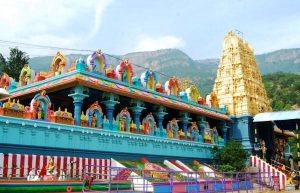
Penchalakona
This is a very ancient sacred place (pilgrim centre). Lord Narasimha manifested Himself here as a huge of rock in ‘Yoga mudra’(in an entwined contemplative posture) and hence it acquired the name of ‘Penusila’ (huge rock) and in course of time became famous as ‘Penchalakona’. Legend has it that after slaying the demon Hiranya Kasipa, Lord Narsimha bathed in Penchalakona and withdrew that ‘Avatara’(incarnation) of Narasimha, shedding His anger and ferocity. The Lord here goes by the name of Somasila Narasimhaswamy and has become one of the Nava Narasimhas (nine manifestations). People belive that because the sage Kanva resided in this area in the past, the river flowing here acquired the name Kanva Nadi and that with efflux of time it became Kandaleru. It is also learnt that the temple was renovated in the 10th century.
Mannar Poluru

Mannar Poluru
Mannar Poluru- Alghu Malluru Krishna Swamy temple is existing in the Mannarpoluru Village, right from the time of Telugu Chola rulers. The village is close-by to Sullurupet, at a distance of 103 Km. from Nellore. It was built in the 17th century by Bangaru Yadama Nayudu, the living place of mallayodas or wrestlers. According to a legend, it was here that Lord Sri Krishna defeated Jambavantha in a duel and married his daughter Jambavati and that Lord MahaVishnu deflated the bloated ego of Garutmata here alone. Apart from the idol of Satyabhama and Jambavati, the two consorts of Lord Krishna, the idol of Jambavantha creating the illusion of shedding tears are bound to amaze the viewers. One cannot help marvelling at the sculptural splendour exuded by the idols of the beauties.
Chengalamma Temple — Sullurupet

Chengalamma Temple, Sullurpet
Goddess Chengalamma Parameswari manifested Herself in the village of Sullurupet which lies 100Km. away from Nellore on the Kolkata-Chennai highway and the temple for Her was built on the bank of the Kanlangi river. History tells us that it was established during the fourth and fifth centuries. People also refer to her as the village goddess â??Tenkaliâ?�. With the passage of time, she is being worshipped regularly by devotees as Chengalamma. Devotees turn up in large number to witness â??Chengalamma Jataraâ
1 note
·
View note
Text
Built in the fifth century, Sri Lanka’s Sigiriya fortress
Sigiriya was built by the fifth-century king Kashyapa I, who ruled the native Sinhalese dynasty, the Moriya. The imposing fortress was the capital of the Sinhalese kingdom until Kashyapa was defeated in A.D. 495.
After Kashyapa, dynasties rose and fell, their fortunes shaped by internal power struggles and conflicts between native Sinhalese and outside invaders from India.
It was designated a UNESCO World Heritage site in 1982) is
0 notes
Text
Samudra Manthan – All the Information You Need

Sage Durvasa’s curse on Indra weakened the Devas, so the Asuras attacked Swarga. Due to their lack of strength, the Devtas were forced to abandon the battle and leave heaven to survive. They approached Brahma for assistance, who then forwarded them to Vishnu.
Vishnu suggested the Devas make a peace offer to the Asuras for something valuable. The Devas considered it and approached the Asuras. After a truce, Devtas, and Asuras churned Kshira Sagara for Amrita. Vasuki was the rope and Mandara (Samudra Manthan) was the spinning rod.
Do you know what 14 things came from Samudra Manthan? Get an online astrology consultation by the world-renowned Astrologer Mr. Alok Khandelwal.
They churned using Mandara mountain and Vasuki, as instructed by Vishnu, and threw all kinds of therapeutic herbs into the ocean. Vishnu instructed the Devas to join hands with Asura King Maharaja Bali. Asuras and Devas carried the mountain. The mountain’s weight fatigued most Devtas and Asuras. Many died. Vishnu and Garuda then placed the mountain in the water.
Vishnu urged Garuda to depart so Vasuki could come. Brahma sat atop the mountain for equilibrium. Asuras and Devas called Vasuki, who they wound around a mountain.
Asuras didn’t want the snake’s tail since they thought it was inauspicious, so Devtas took it. The Kashyapa, Deva, and Asura sons started churning the milky ocean after fine-tuning every aspect.
Even if Devtas and Asuras’ hands were strong, the mountain lacked strength in the ocean and sank. Then Vishnu (in his Kurma Avatar) jumped into the water. He made Mandara Mountain an island 800,000 miles long. Vishnu sensed scratching on the tortoise’s back instead of weight. Devtas and Asuras were revived and resumed churning. Vasuki’s smoke and fire weakened the Asuras.
The first product to emerge was halahal after years of churning (poison). Its venom threatened the world. It’s the universe’s most toxic poison. Devas and Asuras collapsed. Vishnu said only Shiva could stomach the poison.
Devas and Asuras sought Shiva’s help on Mount Kailash. Shiva drank the poison. Devi Parvati held Shiva’s neck poison while sipping halahal. So, she was called Vishakantha, which means “one who managed to hold poison in his throat.” The poison stained Lord Shiva’s neck blue, hence he was dubbed Nilakantha.
Shiva cleaved the mountain with his Trishul to quench his poison-induced hunger. When Shiva drank poison, some droplets dripped on his fingers, which venomous animals ate.
Devtas and Asuras started churning when the universe was safe and all the halahal was drunk. Then Kamdhenu or Surabhi emerged after churning. The Surabhi cow generated all the yogurt, milk, and ghee needed for Vedic rites.
Uccaihsrava arrived. Seven-headed flying horse. Indra granted Bali Maharaja’s request for the horse.
Read Also:- The most confident zodiac signs of Astrology
Eight male and eight female elephants appeared. Male was led by Airavata, female by Abhramu. Indra rode Airavata.
Kaustubha-Mani and Padmaraga-mani were the world’s most precious jewels. Devas and Asuras both gave Lord Vishnu the Kaustubha.
Then came the magnificent Parijat flower, which never wilts. Devas brought it to Indraloka.
After that, under the direction of Rambha, Menaka, and Punyasthala, the Apsaras arrived. They wore jewelry and lockets with seductive attire. Apsaras picked Devas as a partner.
Then the Goddess of Fortune, Lakshmi, materialized and took Vishnu as her eternal husband.
After Laxmi, the Asuras claimed the goddess Varuni or Sura. Varuni or Sura created alcohol.
Different sources say these came from Ksheera Sagar:
A demon’s strong bow symbolizes his aggression.
Chandra, Shiva’s moon Shankha, Vishnu’s conch.
Varun took an umbrella.
Lord Indra gives Goddess Aditi earrings (sloth)
Years passed, but no Amrit appeared. They became tired and impatient. Then a strong man with a jug of Amrita appeared. Dhanvantari was an Avatar of Vishnu and the God of Ayurveda.
Asuras seized Dhanvantari’s jug as he arrived. Again, Asuras and Devas fought over Amrit. When they struggled, four drops of Amrit fell in Allahabad or Prayag, Haridwar, Ujjain, and Nasik. These places have Kumbh Mela every 12 years.
Continued struggle To end it, Vishnu took the appearance of the lovely damsel Mohini and informed the Asuras she would divide the Amrit fairly among the gods and demons. The Asuras were so enchanted by Mohini that they were duped. Only the Devas could receive the Amrit she was delivering.
Rahu took the shape of a Deva and sat among them. His luminosity was unlike the Devas’. Surya and Chandra observed and told Vishnu in Mohini. Mohini severed his head with Sudarshana Chakra. But Rahu took Amrit. He survived. His head, Rahu, and body, Ketu, later become planets.
At its conclusion, there was yet another conflict between the Devas and the Asuras. This time, immortal Devas beat Asuras.
Read Also:- Know more about the fire sign Sagittarius
0 notes